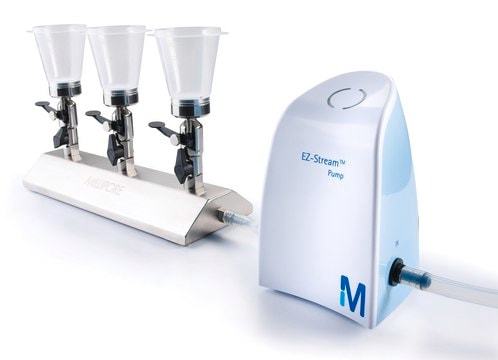W248703
Acide formique
≥95%, FCC, FG
Synonyme(s) :
Acide formique, Ameisensaeure, Aminic acid, Formisoton, Formylic acid, Methanoic acid, Sybest
About This Item
Produits recommandés
Source biologique
synthetic
Niveau de qualité
Qualité
FG
Halal
Kosher
Agence
meets purity specifications of JECFA
Conformité réglementaire
EU Regulation 1334/2008 & 178/2002
FCC
FDA 21 CFR 117
FDA 21 CFR 172.515
Densité de vapeur
1.6 (vs air)
Pression de vapeur
44.8 mmHg ( 20 °C)
Pureté
≥95%
Forme
liquid
Température d'inflammation spontanée
1004 °F
Limite d'explosivité
57 %
Indice de réfraction
n20/D 1.370 (lit.)
pH
2.2 (20 °C, 2.2 g/L)
Point d'ébullition
100-101 °C (lit.)
Pf
8.2-8.4 °C (lit.)
Densité
1.22 g/mL at 25 °C (lit.)
Traces d'anions
sulfate (SO42-): ≤0.004%
Traces de cations
As: ≤3 ppm
Cd: ≤1 ppm
Hg: ≤1 ppm
Pb: ≤10 ppm
Application(s)
flavors and fragrances
Documentation
see Safety & Documentation for available documents
Allergène alimentaire
no known allergens
Propriétés organoleptiques
pungent; vinegar
Chaîne SMILES
OC=O
InChI
1S/CH2O2/c2-1-3/h1H,(H,2,3)
Clé InChI
BDAGIHXWWSANSR-UHFFFAOYSA-N
Vous recherchez des produits similaires ? Visite Guide de comparaison des produits
Description générale
Application
- Quantitative Analysis of Residual Butylated Hydroxytoluene and Butylated Hydroxyanisole in Salmo Salar, Milk, and Butter by Liquid Chromatography-Tandem Mass Spectrometry.: In this study, formic acid is used in the preparation of samples for liquid chromatography-tandem mass spectrometry analysis. The research focuses on the detection and quantification of antioxidant residues in food products, contributing to food safety and quality control protocols (Galal et al., 2024).
Mention d'avertissement
Danger
Mentions de danger
Classification des risques
Acute Tox. 3 Inhalation - Acute Tox. 4 Oral - Eye Dam. 1 - Flam. Liq. 3 - Skin Corr. 1A
Risques supp
Code de la classe de stockage
3 - Flammable liquids
Classe de danger pour l'eau (WGK)
WGK 1
Point d'éclair (°F)
121.1 °F - closed cup
Point d'éclair (°C)
49.5 °C - closed cup
Équipement de protection individuelle
Faceshields, Gloves, Goggles, type ABEK (EN14387) respirator filter
Faites votre choix parmi les versions les plus récentes :
Déjà en possession de ce produit ?
Retrouvez la documentation relative aux produits que vous avez récemment achetés dans la Bibliothèque de documents.
Les clients ont également consulté
Notre équipe de scientifiques dispose d'une expérience dans tous les secteurs de la recherche, notamment en sciences de la vie, science des matériaux, synthèse chimique, chromatographie, analyse et dans de nombreux autres domaines..
Contacter notre Service technique






